Our History
1900 - 1950
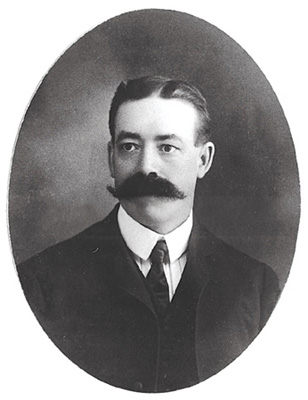
1903
William Dustin Corn meets at the Young Men’s Christian Association (YMCA) on the evening of October 16, with a group of about 20 men interested in attending evening law classes. That evening, they decide to establish a law school as part of a national program begun by the YMCA to enable all interested American citizens, regardless of race, sex, or social strata to gain a legal education. The Columbus Law School is one of 14 law programs established across the country at this time by the YMCA to assure access to a legal education by qualified men and women who could not afford a full-time law school, yet were willing to devote their evenings to study the law.Corn is instrumental in setting up the first classes and serves as the first dean until 1906 when he joins the law faculty at Ohio Northern University. Henry S. Ballard, who read law in Corn’s law office, joins Corn as the first faculty member.
The first evening classes in the “Y” building are held on South Third Street, across from the Capitol. Today, the site is the location of the Columbus Dispatch.
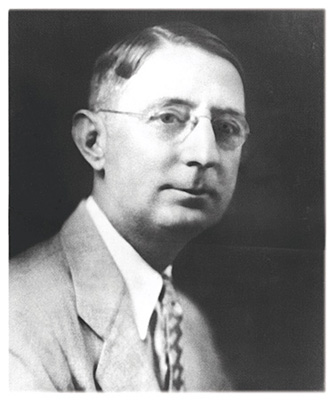
1906
The Supreme Court of Ohio recognizes the Columbus Law School.
1908
Henry G. Binns and James E. Bauman become the first Columbus Law School students to score better than 85 percent on the Bar Examination.
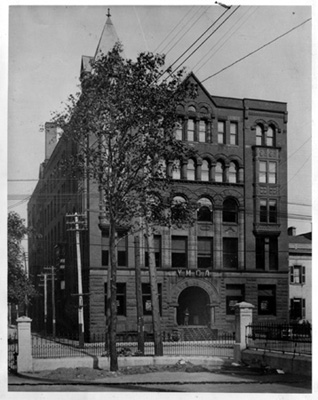 Third Street Location
Third Street Location1913-1917
The law school program is temporarily on hold, except for a few students who study on their own initiative, due to World War I and a lack of activity.
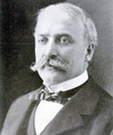 Charles Hunter TN
Charles Hunter TN1916
Charles O. Hunter, a Columbus attorney, donates about 1,000 volumes to start the law school library.
1917
Under the leadership of Charles M. Roudebush, director of the YMCA schools, the law school is reorganized into one of five schools at the Y. Fourteen students are enrolled this year.
1918
Women enter the law school’s program for the first time, but it is not until 1926 that a woman earns a law degree.
1920
The school is incorporated as the Columbus Evening Law School of the YMCA of Columbus
1921
The power to confer the LL.B. degree is granted by the Ohio Supreme Court. The name is changed to the YMCA Evening Law School
1922
The name changes again, this time to the Columbus YMCA Law School . The law school offers a four-year course leading to a Bachelor of Laws, followed by a two year course for a Master of Laws.
 YMCA Building TN
YMCA Building TN1923
The law school, under the name of the Columbus College of Law, moves with the YMCA to its newly constructed building on 40 East Long Street; the building remains today the facilities of the Central Ohio YMCA. The school retains this name until 1948.
1923
A high school diploma is required for entry into law school.
1924
The first formal graduation is conducted on June 11, 1924. Eight degrees are conferred.
1926
On June 9, 1926, Esther Brocker, the first woman alumnae, graduates from the law school. For four years, Esther, the mother of a 13-year-old son, drove in fair weather and foul between her home in Lancaster, Ohio and Columbus to attend classes three times a week. In a December 1998 newspaper article, her great-granddaughter recalled some of the hardships she endured as a student: “When a touchy subject came up during class, something they felt a woman should not hear, Esther was made to leave the classroom and the class would discuss it without her. Then afterwards, a classmate would have to explain to her what they talked about.”
1927
Admission requirements are upped to a high school diploma plus one year of college.
1928
Admission requirements are increased to a high school diploma plus two years of college totaling 60 semester hours.
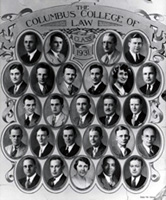 Class of 1931 TN
Class of 1931 TN1931
David D. White, the first African-American, graduates from the law school. Mr. White is the first black attorney licensed to practice in Columbus. Capital University Law School’s David D. White Scholarship was established in his honor.
1931
John M. Matthias becomes the first graduate of the Columbus College of Law to place first in the state on the bar exam. Mr. Matthias later becomes a Justice on the Ohio Supreme Court serving from 1954 to 1970.
1933
Franklin University is founded as the new educational arm of the YMCA. All of the schools it operates, including the Columbus College of Law, fall under Franklin’s umbrella.
1934
January 6, 1934, the Franklin University Student Bar Association begins; this is the first such organization in Ohio.
1934
On March 18, the law school becomes a charter member of the League of Ohio Law Schools, an organization created by the Ohio Supreme Court to establish and maintain high standards in legal education in Ohio through a state accreditation process.
1935
On February 15, the Columbus College of Law Alumni Association is formed. Judge C.P. McClelland of the Franklin County Probate Court is elected the first president. Dues are $1 a year.
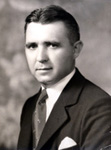 Ralph H Klapp TN
Ralph H Klapp TN1948
The law school changes its name to Franklin University Law School.
1950
On February 27, the law school receives conditional ABA sanctioning and is placed on the approved list of the Section of Legal Education of the ABA.
1951 - 2000
1954
On August 18, 1954, the law school achieves full accreditation from the Section of Legal Education and Admissions to the Bar of the American Bar Association.
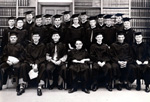 Class of 1960 TN
Class of 1960 TN1964
On June 23, 1964, Franklin University ends its ties to the YMCA and becomes an independent, non-profit corporation.
1965
It becomes apparent that if Franklin University Law School is to continue, it is necessary to move the school to an accredited undergraduate university where better physical facilities can be obtained and there is room for expansion. Franklin board members recognize the importance of preserving the law school as a needed element of legal education in Columbus. Joint action to move the law school to Capital University is taken by the Franklin University and Capital University boards on December 13, 1965.
1966
 Willaman Building TN
Willaman Building TNOn September 1, the law school officially becomes a part of Capital University, under the leadership of Deans John McCormac and John Sullivan. The law school moves to Capital’s Bexley campus. Law classes are held in Troutman Hall and Huber-Spielman Hall while the Law Library and faculty offices are housed in the renovated Willaman Building, a former Chevrolet dealership on E. Main St. across from Capital’s main campus. The school retains the name Franklin Law School of Capital University.
1966
On September 10, a gala inaugural convocation is held for about 2,000 faculty, students, alumni and guests. Among the speakers are Ohio Supreme Court Chief Justice Kingsley A. Taft, U.S. Senator Frank J. Lausche, and Tom Moody, a 1956 Franklin University Law School graduate and future mayor of Columbus. The law degree is redesignated from an LL.B. to a Juris Doctor and the J.D. degree is awarded to the 336 alumni present and about 200 other alumni in absentia.
1969
The law school is granted approval by the American Bar Association to start a full-time day law program. Fifty-one students enroll in the first full-time day classes.
1971
 Night Prosecutor program TN
Night Prosecutor program TNProfessors William H. Bluth and Terrence F. Kiely establish the Capital University Law Clinic. Third year law students are permitted by the Ohio Supreme Court to represent clients in Ohio courtrooms under the supervision of a licensed attorney. The Legal Clinic continues today under the directorship of Professor Danny Bank.
1971
The Night Prosecutor Mediation Program is established with the cooperation of Columbus City Attorney James Hughes and Professors Josiah Blackmore, Terrence Kiely and John Palmer. Criminal misdemeanor complaints are mediated through hearings conducted by Capital University law students. This is the first major mediation program in the nation and later is adopted by the American Bar Association as a prototype for cities around the country. Initial funding is provided by a Law Enforcement Assistance Administration (LEAA) grant of the U.S. Department of Justice. In 1974, the program is designated an Exemplary Project by the National Institute of Law Enforcement and Criminal Justice of LEAA. The program receives many other awards during its early years from the ABA, Governor, and World Congress of Victimology and the program is written about in Time, Newsweek, and U.S. News and World Report. In 1977, Larry Ray, L’77, serves as the first full-time executive director of the program. In late 1979, Scot Dewhirst, a 1978 graduate of the Law School and today, the co-director for Capital’s Center for Dispute Resolution, directs the program for the next eight years.
1972
To avoid public confusion over sponsorship, the Capital University Board of Regents changes the name of Franklin Law School of Capital University to Capital University Law School.
1972
A certified Legal Assistant Program, endorsed by the Columbus Bar Association, begins. This program, a first of-its-kind in the nation to offer paralegal studies for post-baccalaureate students, is directed by former Dean and Professor John McCormac and assisted by Professor Carole (Butler) Berry.
1972
The Capital University Law Review unveils its first edition in the Spring of 1972. The first editor-in-chief was Professor Roberta Mitchell.
1977
The decade of the 1970s is a time of tremendous growth and achievement. The increase in enrollment, faculty, library resources, and student opportunities puts many pressures on the existing Willaman building. Capital University launches a fundraising campaign, Venture: Capital, for major capital improvements, including a new law school building.
1978
The John E. Sullivan Lecture Series is established in honor of Professor John E. Sullivan, a dedicated teacher and scholar who joined the Law School faculty in 1953 and served as acting dean and academic dean during his tenure. The Sullivan Lecture is presented each academic year by a distinguished legal scholar who addresses a matter of significance to the Law School and to the greater legal community. The Sullivan Lecture Series is made possible through an endowment established by Herbert and Margith Kunmann, friends and benefactors of Capital University Law School. Their son, Edmond J. Kunmann, is a 1985 graduate of Capital Law School.
1980
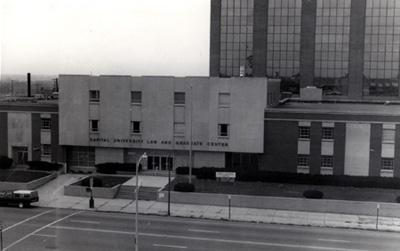 Grange Building TN
Grange Building TNOn January 14, 630 law students and twenty-five full-time faculty members move to the new, leased facilities at 665 South High Street — the former Grange Mutual Insurance building. A new name emerges to reflect the inclusion of classrooms and other facilities for Capital’s Graduate School of Administration — Capital University Law & Graduate Center. The building is formally dedicated on May 24, 1980.
1980
May 21, the Law School Alumni Association board convenes for the first time.
1982
Spring Semester 1982 sees one of the Law School’s first ventures into inter-professional education. Law students and Trinity Lutheran Seminary students take part in a Seminar in Biomedical Law & Ethics that is team-taught by Professor Lance Tibbles and Trinity Lutheran Seminary Academic Dean James Childs.
1983
 AALS Meeting 1983 TN
AALS Meeting 1983 TNJanuary 6, the Law School is admitted as the 145th member of the prestigious Association of American Law Schools during the AALS annual meeting held in Cincinnati, Ohio.
1984
Capital University establishes a summer program for law students offered at the University of Copenhagen, Denmark. Professor John Palmer is the first director. The summer abroad program continues for two years and is restarted in 1997 with a summer abroad program in Greece under the direction of Professor Robert Wade.
1984
Professor Roberta Mitchell and Adjunct Professor Scot Dewhirst, with faculty approval, establish the Center for Dispute Resolution. Among the CDR’s first activities are trainings for individuals who want to create a mediation program similar to the Night Prosecutor Mediation Program. Capital’s first contact with the Jamaican government also begins this year.
1984
Former Bankruptcy Judge Grady L. Pettigrew, Jr. and Professor Michael Distelhorst establish The North Central Bankruptcy Institute. The institute offers continuing education programs to bankruptcy judges, lawyers and others who have an interest in this area. The institute is eventually transferred to the Graduate School of Administration (now the School of Management) to be a part of its executive and continuing education programs division.
1984
The Law School offers its first combined degree – the joint JD/MBA with the Capital University Graduate School of Administration.
1985
Initiated by Dean Blackmore and Starr Huffman in Tokyo, Japan, the Law School begins the American Legal Studies in Japan Program with Professor Michael Distelhorst serving as director. At the time, Honda of America Manufacturing and its supplier’s are building plants in central Ohio and creating a demand for legal services and understanding. The program is designed to run for three years, and offers courses in American law for members of the Tokyo bar and other Japanese attorneys. The program is facilitated by Mr. Kuni Sadamoto and Survey Japan in Tokyo. The courses are taught by members of major law firms in Columbus (including Porter, Wright, Morris & Arthur, LLP; Schottenstein, Zox & Dunn; and Vorys, Sater, Seymour and Pease, LLP), nationally recognized professors from other law schools, and several members of the Law School faculty.
1985
Development of the Jamaica/Capital Project begins to address concerns expressed by Jamaican government officials over the rise of violence in their country. Center for Dispute Resolution Co-Director Scot Dewhirst visits Jamaica to initiate discussions about a country-wide dispute resolution program for courts, communities and law enforcement. In 1989, the project receives a $200,000 Ford Foundation Grant. Efforts culminate in a National Symposium on Dispute Resolution in 1990. The Jamaican government declares the week of September 24, 1990 to be National Dispute Resolution Awareness Week and the Mediation Council of Jamaica holds its first meeting. In 1994, the U.S. Agency for International Development awards a $200,000 grant under its Sustainable Justice Improvement Program with the Government of Jamaica to continue dispute resolution activities. The Mediation Council incorporates and becomes the Dispute Resolution Foundation.
1986
 Graduate Law Faculty TN
Graduate Law Faculty TNWith the leadership of Associate Dean Robert Wade, a Graduate Tax Program is approved by the ABA. Twenty-six graduate lawyers begin their studies towards a Master of Laws (L.L.M.) in Taxation, and twenty-six graduate accountants begin their studies towards a Masters in Taxation (M.T.). The first full-time tax faculty members are Carole (Butler) Berry, Addison Dewey, Richard Donovan, David Johnston, Robert Wade and Ronald Worley. In addition, prominent tax lawyers and accountants in central Ohio and law professors from The Ohio State University teach some specialized courses.
1987
In November, Capital’s National Moot Court Team wins the national championship. The team of all evening students is comprised of Benson Wolman, Deborah Roeger, and Susan Geary. A second team from Capital finishes in the final eight – Jane Kirkeide, Jenny Marks, and Bradford Arnold. Professors Roberta Mitchell and Brian Freeman are the team’s advisors.
1988
The law school is approved by the Section of the Legal Education and Admissions to the Bar of the American Bar Association to offer a Master of Laws (LL.M) in Business and Taxation for graduate lawyers. The name of the Graduate Tax Program is changed to the Graduate Tax & Business Law Program.
1991
The Ethics Institute, co-directed by Professor Lance Tibbles and Professor Michael Distelhorst is established to provide an institutional focus for interdisciplinary scholarship, research and education about legal, professional and business ethics. With the help of various grants, the Institute is able to offer continuing education and large conference programming to the Columbus and Ohio legal and business communities. The Institute is eventually joined by the Graduate School of Administration (now the School of Management), the School of Nursing, and Trinity Lutheran Seminary in offering multi-disciplinary continuing education programs and the first interdisciplinary course in which law students, graduate business school students, nursing students, and theology students comparatively study one another’s professional ethics. The Institute’s “Essays in Justice Series” is nationally recognized for spotlighting leading authorities in legal, business, healthcare, and pastoral ethics. The Institute’s efforts in large conference programs and its speakers' bureau are both important parts of its current work, along with various newer programs such as its hosting of lawyer disciplinary hearings at the Law School and its professionalism programs for law students.
1991
The first International and Comparative Law Summer Program, under the name “Summer Abroad at Home,” is held at the law school, attracting four distinguished foreign visiting scholar/teachers. This first-of-its-kind, the program operates under the direction of Professor Ronald Friedman, Director of the Institute for International Legal Education. The first international Distinguished Visiting professor, Leszek Garlicki, from University of Warsaw Faculty of Law and Administration, in Poland is welcomed.
1991
Dean Rodney K. Smith signs a letter of understanding with Vice-Dean Marek Wierzbowski, University of Warsaw Faculty of Law and Administration, Warsaw, Poland, to undertake and facilitate faculty and student exchanges between the United States and Poland. Vice-Dean Marek Wierzbowski, University of Warsaw Faculty of Law and Administration, Poland is the Fall 1991 Distinguished Visiting Professor. Professor Jacob Dolinger, State University of Rio de Janeiro, Brazil is the Spring 1992 Distinguished Visiting Professor.
1991
During the summer, the Center for Dispute Resolution sends a team of trainers that includes Professor Roberta Mitchell, Adjunct Professor Scot Dewhirst and Timothy Lytton to conduct mediation training for law students at the Universidad Nacional Autonoma de Nicaragua (UNAN) in Leon. Training materials are created in Spanish and role plays are adapted to the needs of Nicaraguans. The need for a mediation initiative in Nicaragua became clear when the civil war ended in 1989 and confusion over property rights arose.
1992
The Center for Dispute Resolution and the Institute for International Legal Education, together with the Universidad Nacional Autonoma de Nicaragua, host an international conference for North, South and Central American legal scholars, government officials and policymakers. The conference provides a forum in which participants can discuss the role of property in a participatory democracy and debate policy options for the peaceful resolution of agrarian conflicts.
1993
The Law School and Ohio University Sports Administration Facility Management program establish a joint degree program enabling students to earn both a juris doctor and a master’s of sports administration degree.
1994
A joint JD/ Master of Science in Nursing degree is launched with Capital's School of Nursing.
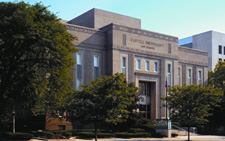 Broad Street Building TN
Broad Street Building TN1997
In August, the Law School moves to 303 E. Broad Street, the former home of the Columbus Life Insurance Company. The building is formally dedicated June 6, 1998 and the name returns to Capital University Law School.
1997
The Peter F. Frenzer Nationwide Insurance Training Facility is established in recognition of the Center for Dispute Resolution’s long-time partnership with Nationwide. Nationwide Insurance Enterprise Foundation provided Capital University Law School with a $1 million corporate donation to name the facilities that house the Center for Dispute Resolution. The gift is given in honor of Peter F. Frenzer, retired president and chief executive operating office of Nationwide Life Insurance. CDR’s affiliation with Nationwide dates back to 1991 when both organizations shared an interest in applying dispute resolution processes and skills in the insurance industry. CDR has worked with Nationwide to identify the applications of negotiation and mediation to issues and problems of concern in the insurance industry. One result has been the development and implementation of a negotiation self-study course for claims representatives.
1998
In July, The National Center for Adoption Law & Policy at Capital University Law School is founded with the strong support of the Dave Thomas Foundation for Adoption. The Center is a nonprofit organization that seeks to improve the laws, policies and practices associated with child protection and adoption systems and is directed by Professor Kent Markus. Using research, advocacy and education, the Center works to bring change to the system throughout the nation. Its services include Adoption LawSite, the nation’s first comprehensive online compilation and synthesis of the law of adoption which provides free access to the adoption related statutes and regulations, as well as the key cases and articles, from every U.S. state and territory, along with federal and international materials; weekly news and case summaries, an annual symposium on a significant child welfare/adoption-related topic; Adoption JobSite to match law students from across the nation with private, public and nonprofit employers working in child welfare and adoption law and policy; amicus curia activity.
2000
In the fall of 2000, the Law School debuts one of the first Master of Laws in Business degrees offered in the nation. The LL.M. in Business program is well suited to the professional who wishes to strengthen legal and business acumen to better serve clients and employers in a multifaceted, global marketplace.
2000
Capital University Law School’s Family Advocacy Clinic is established with an initial $250,000 grant from the Columbus Coalition Against Family Violence, founded in 1996 by Abigail Wexner. The Clinic serves victims of domestic violence who do not meet eligibility criteria to receive legal aid assistance, but who are still unable to afford a private attorney. The Clinic works to improve the legal and community services available to family violence victims within Franklin County and works to encourage community collaboration. Partners include the Legal Aid Society, CHOICES Shelter, and the Columbus City Attorney’s Office. Within the Family Advocacy Clinic, students may choose to intern in either the Civil Protection Unit or the Child Custody Unit. In the Civil Protection Unit, students work with staff attorneys to file civil protection orders in the Domestic Relations Court to protect victims of domestic violence. The Unit also provides assistance with housing needs, employment concerns and divorce or dissolution proceedings. The Child Custody Unit offers legal representation in contested child custody cases when family violence has been involved.
2001 - Present
2001
In February, Capital begins a Legal Nurse Consultant program with 38 students.
2001
The law faculty adopts a new writing graduation requirement for students beginning Law School in fall 2002. In addition to completing the comprehensive first-year legal Research and Writing course and writing a scholarly article of publishable quality, student are now required to complete a Legal Drafting course in their final year of law school study.
2002
In February, Capital University Law School wins the 10th Annual National Sports Law Moot Court Competition held in New Orleans. The National Sports Law Moot Court Competition, sponsored by Tulane University School of Law, is based on a contemporary legal problem confronting the sports industry. Members of Capital’s winning team are Christopher Slagle of Gallipolis, Ohio; Lyndsey Sloan of Columbus, Ohio; and Carrie Snoke of Lancaster, Ohio. The team is coached by Professor Daniel Turack.
2002
In October, Capital launches its newest post-baccalaureate certificate program, the Life Care Planner certificate. The program explores the intersection between law and medicine and reaches out to those with nursing or rehabilitation expertise to work with the legal team in cases involving clients with catastrophic illnesses or injuries.
2002
The faculties of Trinity Lutheran Seminary and Capital University Law School create a joint degree program to enable students to complete both a juris doctor and a master of theological studies. A graduate with a J.D./M.T.S. degree is well prepared to deal with the complex ethical questions of our time and is useful for persons seeking to work in the public policy arena or with religiously-based organizations.
2002
The Law School faculty and the Capital University Board of Trustees adopt a Strategic Plan for the law school as it enters its second century. The goals of the plan are to 1) become a more selective law school and admit students who are both well-qualified and committed to the values of the legal profession; 2) provide a high-quality, academically rigorous legal education that integrates theory with practice; 3) foster the Law School’s centers of strength; 4) attract and retain a world-class faculty of teacher/scholars and retain Central Ohio’s best lawyers as adjuncts; and 5) develop a strong resource base and endowment to fund a quality educational experience and increase the value of Capital University Law School to students and the community.
2003
Athornia Steele is named the Law School’s first African-American Dean. He was selected as interim dean to replace Stephen Bahls.
2004
Jack Guttenberg is selected as the Law School’s dean. He previously was on the faculty at Cleveland-Marshall College of Law, Cleveland State University since 1980 and served as associate dean there from 1997 to 2004.
2005
In response to a desire to improve the Law School graduates’ performance on the bar exam, Capital University Law School hires Professor Yvonne Twiss to create one of the nation’s first for-credit bar success preparation courses, Advanced Bar Studies. This program helps students prepare for the bar exam, focusing on test-taking techniques, a familiarization with the multiple choice test, Ohio essay questions and multi-state performance test questions. The program was so successful that is became a model copied by other law schools across the country.
2007
Capital University Law School revamps and restructures its Academic Success Program, which eases the transition into law school. Law school requires different study methods than may have been successful at the undergraduate level, and the Academic Success Program was created to offers a wide range of information to help CapLaw students maximize their potential for achievement.
2008
Capital University Law School graduates place first in the state in terms of bar passage among first-time test takers.
2010
Richard Simpson is selected as the Law School’s new dean. Simpson previously had worked as a managing partner at Bricker & Eckler LLP, one of Ohio’s largest law firms.
2011
The Law School completes its new strategic plan. The strategic priorities identified in the plan included promoting teaching excellence and innovation, being student supportive, impacting the professional legal community, fostering meaningful scholarship and establishing a foundation for continuity. Of the 27 strategic objectives identified to achieve those priorities, the top six were ensuring fiscal soundness and reserve; maintaining a strong bar passage rate; emphasizing practice-ready skills through experiential learning; benchmarking innovations by our teaching competitors and reviewing our curriculum to ensure an appropriate balance of doctrine and skills learning; enhancing career guidance and job search assistance efforts; and actively cultivating relationships with hiring organizations.
2011
Capital University Law School launches the Small Business Clinic through the Legal Clinic. This program provides experiential learning opportunities to students interested in business law. The clinic provides legal assistance to Columbus based entrepreneurs, small businesses, and nonprofit organizations that cannot afford to pay market rates for legal services. The Clinic helps its clients establish legal business entities such as limited liability companies (LLCs) and corporations (both for-profit and nonprofit). It also assists its clients with other general legal issues that their business or organization is facing.
2011
In light of the national home foreclosure crisis, Capital University Law School creates the Foreclosure Mediation Program. This program gives its students real-world experience while preparing homeowners who are preparing to go through foreclosure mediation. The program is created in cooperation with the Franklin County Foreclosure Mediation Preparation Project of the Court of Common Pleas, as well as other agencies.